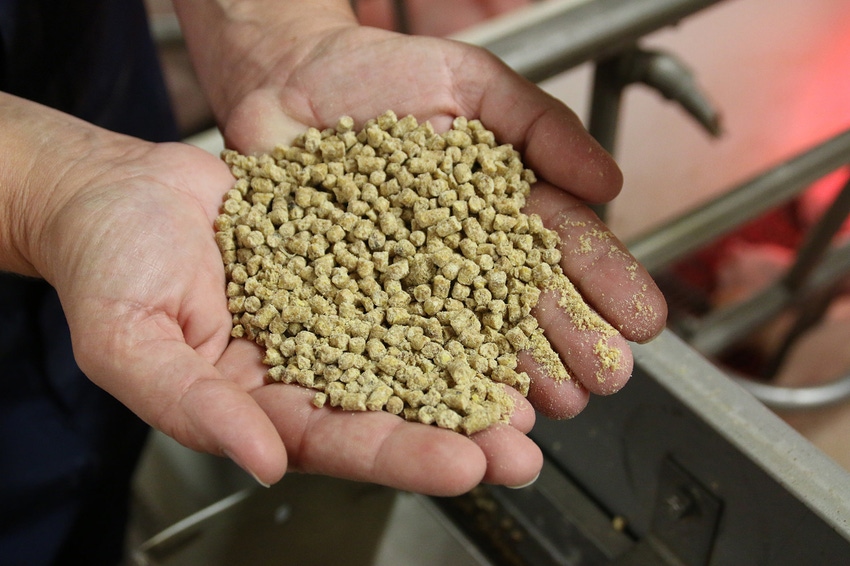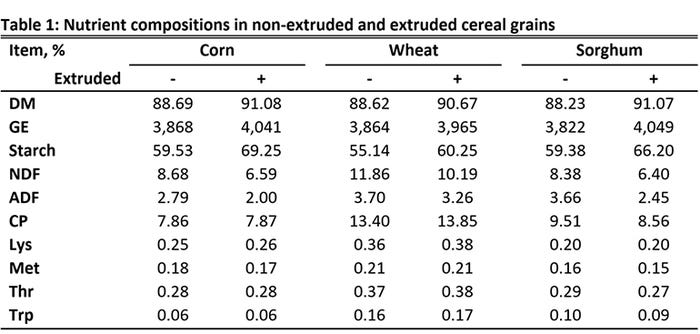Extrusion of grains increases not only the concentration of energy and starch contents, but also the utilization of energy, starch and AA by growing pigs.
November 29, 2018

By Diego A. Rodriguez and Hans H. Stein, University of Illinois
Extrusion of feed ingredients is one of the feed technologies that is commonly used in the pet and aqua feed industry. Extruding diets and ingredients has been considered important for young pigs’ diets for the last few decades because extrusion may improve utilization of energy and nutrients from cereal grains.
The mechanism behind this is related with 1) the gelatinization of starch, and 2) a change in anatomy of the grains. Starch gelatinization is a process in which starch becomes more available to the animals. If grains are processed with appropriate moisture, pressure and heat while extruded, the shape of grain particles are destroyed, and more nutrients are accessible for digestive enzymes.
Corn is one of the primary feed ingredients for livestock in the United States, but wheat and sorghum are also sometimes used. Most diets contain more than 50% grains and the contribution of energy and nutrients from the grains to the diets is high. As a consequence, if extrusion increases the availability of starch and possibly other nutrients then it may increase energy utilization by pigs.
To test this hypothesis, an experiment was conducted with the objective of determining effects of extrusion on composition and digestibility of energy and nutrients and on the concentration of ME of corn, wheat and sorghum.
Nutrient compositions in non-extruded and extruded cereal grains are presented in Table 1. Extruded corn contained approximately 4% more GE and 16% more starch compared with non-extruded corn, but no difference was observed in the concentration of CP and AA. The extruded corn also contained 24% less analyzed NDF. Extruded wheat contained 3% more GE, 9% more starch and 14% less NDF than non-extruded wheat, but no differences were observed on concentration of CP and AA. Extruded sorghum contained 6% more GE and 11% more starch, but the concentration of CP and AA were slightly less than in non-extruded grain. The extruded sorghum also contained about 24% less analyzed NDF.

The reason for the increased starch is most likely that most of the resistant starch in the grains becomes digestible during extrusion. At the same time, some of the insoluble fiber becomes soluble, which is the reason for the reduced concentration of analyzed NDF.
Extrusion increased the apparent ileal digestibility of starch in corn, wheat and sorghum by more than 5% (Table 2). The efficiency of energy from dietary starch is greater when the starch is digested by endogenous enzymes in the small intestine than if starch is fermented by microbes in the hindgut, and the increase in small intestinal digestion of starch that was observed in all extruded grains, therefore, results in increased energy availability for the pig.

Extrusion of grains increased the digestibility of AA as well as the concentration of ME, but effects of extrusion depended on the source of grains. However, fermentability of ADF and NDF was not increased by extrusion, and it is, therefore, likely that the increased concentration of ME is a consequence of increases in digestibility of starch and AA, and increased concentrations of soluble fiber.
Compared with wheat and sorghum, corn was most affected by extrusion. It has been demonstrated that extrusion may be more effective in high-fiber ingredients than in low-fiber ingredients. Nevertheless, results of this experiment indicate that the response to extrusion does not depend on the fiber concentrations in the grains.
In conclusion, extrusion of grains increases not only the concentration of energy and starch contents, but also the utilization of energy, starch and AA by growing pigs.
You May Also Like



